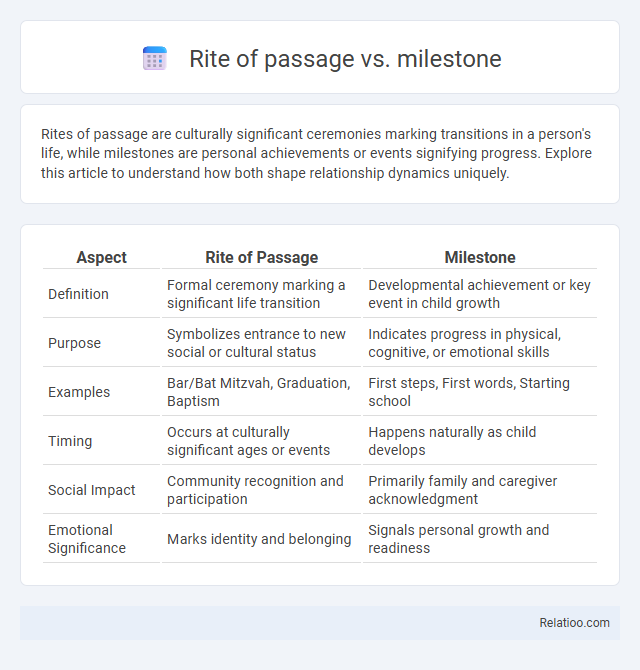Rites of passage are culturally significant ceremonies marking transitions in a person's life, while milestones are personal achievements or events signifying progress. Explore this article to understand how both shape relationship dynamics uniquely.
Table of Comparison
| Aspect | Rite of Passage | Milestone |
|---|---|---|
| Definition | Formal ceremony marking a significant life transition | Developmental achievement or key event in child growth |
| Purpose | Symbolizes entrance to new social or cultural status | Indicates progress in physical, cognitive, or emotional skills |
| Examples | Bar/Bat Mitzvah, Graduation, Baptism | First steps, First words, Starting school |
| Timing | Occurs at culturally significant ages or events | Happens naturally as child develops |
| Social Impact | Community recognition and participation | Primarily family and caregiver acknowledgment |
| Emotional Significance | Marks identity and belonging | Signals personal growth and readiness |
Understanding Rites of Passage
Understanding rites of passage involves recognizing these culturally significant ceremonies marking transitions in a person's life, such as birth, puberty, marriage, or death. Milestones represent significant achievements or events but lack the ceremonial or symbolic depth inherent in rites of passage. Your awareness of these distinctions enhances appreciation of how societies ritualize growth and change through meaningful practices.
Defining Life Milestones
Defining life milestones involves recognizing significant events such as rites of passage and personal achievements that mark transition points in Your life journey. Rites of passage typically encompass cultural or ceremonial rituals signifying a change in social status, while milestones represent measurable accomplishments or stages like graduations or career advancements. Understanding these distinctions helps You appreciate how both symbolic ceremonies and tangible achievements contribute to personal growth and identity formation.
Key Differences: Rites of Passage vs Milestones
Rites of passage mark significant cultural or social transitions, often accompanied by ceremonies or rituals symbolizing a change in status, such as coming of age or marriage. Milestones represent measurable achievements or events within personal or professional progress, like graduating from school or reaching a work anniversary, and do not necessarily involve ritualistic elements. Key differences between rites of passage and milestones lie in the cultural significance and ritualistic context of rites of passage versus the practical and chronological nature of milestones.
Cultural Significance of Rites of Passage
Rites of passage hold profound cultural significance, marking transformative moments that define an individual's transition between social or life stages. Unlike milestones, which are often personal achievements or measurable events, rites of passage are deeply embedded in communal traditions and rituals that reinforce cultural identity and collective values. Your participation in these ceremonies connects you to a broader heritage, fostering a sense of belonging and continuity within your culture.
Common Examples of Rites of Passage
Common examples of rites of passage include birth ceremonies, coming-of-age rituals like quinceaneras or bar mitzvahs, and marriage ceremonies, each marking significant life transitions. Milestones represent important achievements or stages, such as graduating from school or receiving a promotion, but lack the ceremonial or cultural significance inherent in rites of passage. Unlike typical milestones, rites of passage often involve symbolic actions, community participation, and rituals that signify a person's change in social status or identity.
Typical Milestones in Modern Life
Typical milestones in modern life include graduations, first jobs, marriage, and homeownership, marking significant personal and social achievements. These milestones often serve as rites of passage, rituals symbolizing transitions between life stages and reinforcing cultural identity. You can better understand your own growth by recognizing how these events shape your development and social roles.
Psychological Impact: Rites vs. Milestones
Rites of passage often trigger profound psychological transformation by facilitating identity shifts through symbolic rituals and communal validation. Milestones, while marking significant achievements or life events, primarily reinforce self-efficacy and goal attainment without necessarily altering core identity. The psychological impact of rites tends to be deeper and more enduring, often reshaping personal narratives and social roles, whereas milestones serve as cognitive anchors that emphasize progress and motivation.
Role in Identity Formation
Rites of passage play a crucial role in identity formation by marking significant life transitions that affirm social roles and personal growth within cultural contexts. Milestones serve as measurable markers or achievements that reflect individual development and contribute to a person's evolving self-concept over time. Together, rites of passage and milestones shape identity by providing structure, meaning, and recognition of progress through life stages.
Societal Functions and Expectations
Rites of passage serve as culturally significant ceremonies marking transitions between social statuses, fulfilling societal functions by reinforcing communal identity and shared values. Milestones represent measurable achievements within individual or group development, often lacking ceremonial aspects but embodying social expectations through recognized progress markers. The interplay between rites of passage and milestones highlights how societies balance formal recognition of personal growth with broader communal acknowledgment and continuity.
Integrating Rites and Milestones in Personal Growth
Integrating rites of passage and milestones in personal growth enhances self-awareness by marking significant transformations and achievements that define your journey. Rituals like rites of passage symbolize profound change, while milestones represent measurable accomplishments, both together structuring your development path. Recognizing and embracing these experiences encourages intentional progress and deeper reflection during critical life transitions.

Infographic: Rite of passage vs Milestone
 relatioo.com
relatioo.com